oil pressure CHEVROLET SUBURBAN 1996 Owners Manual
[x] Cancel search | Manufacturer: CHEVROLET, Model Year: 1996, Model line: SUBURBAN, Model: CHEVROLET SUBURBAN 1996Pages: 486, PDF Size: 26.58 MB
Page 13 of 486
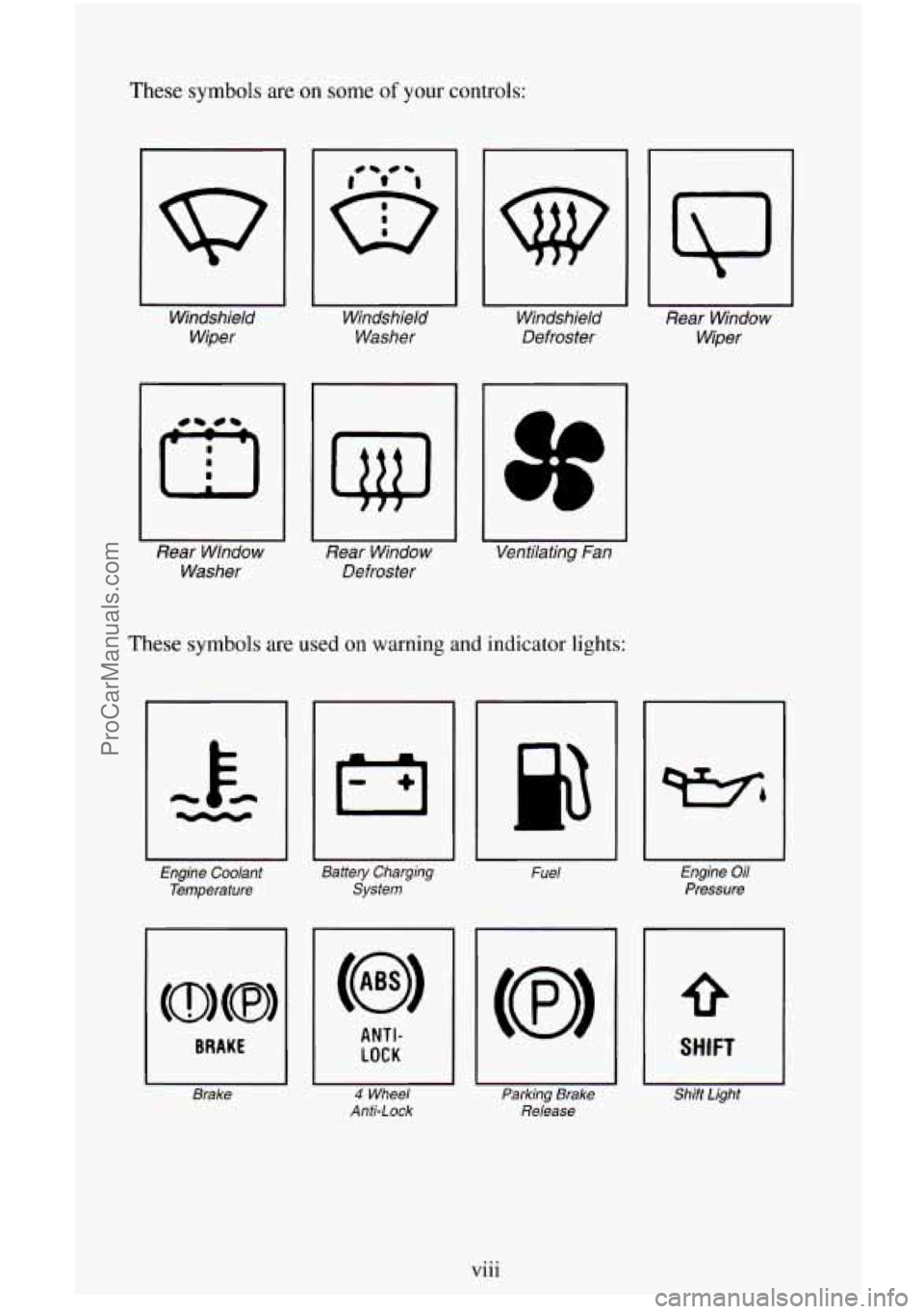
These symbols are on some of your controls:
I
Windshield
Wiper Windshield
Washer
Rear Wlndow Washer
I
Rear Window
Defroster
w
I
Windshield
Defroster
U
Ventilating Fan
These symbols are used on warning and indicator lights:
I -k 4cccy
Engine Coolant
Temperature
BRAKE
I Brake
I I
Battery Charging
System
ANTI-
I LOCK
I I 4 Wheel
Anti-Lock
Fuel
Parking Brake Release
I\J
Rear Window
Wiper
Engine Oil
Pressure
SHIFT
Shift Light
viii
. ~ .. ProCarManuals.com
Page 83 of 486
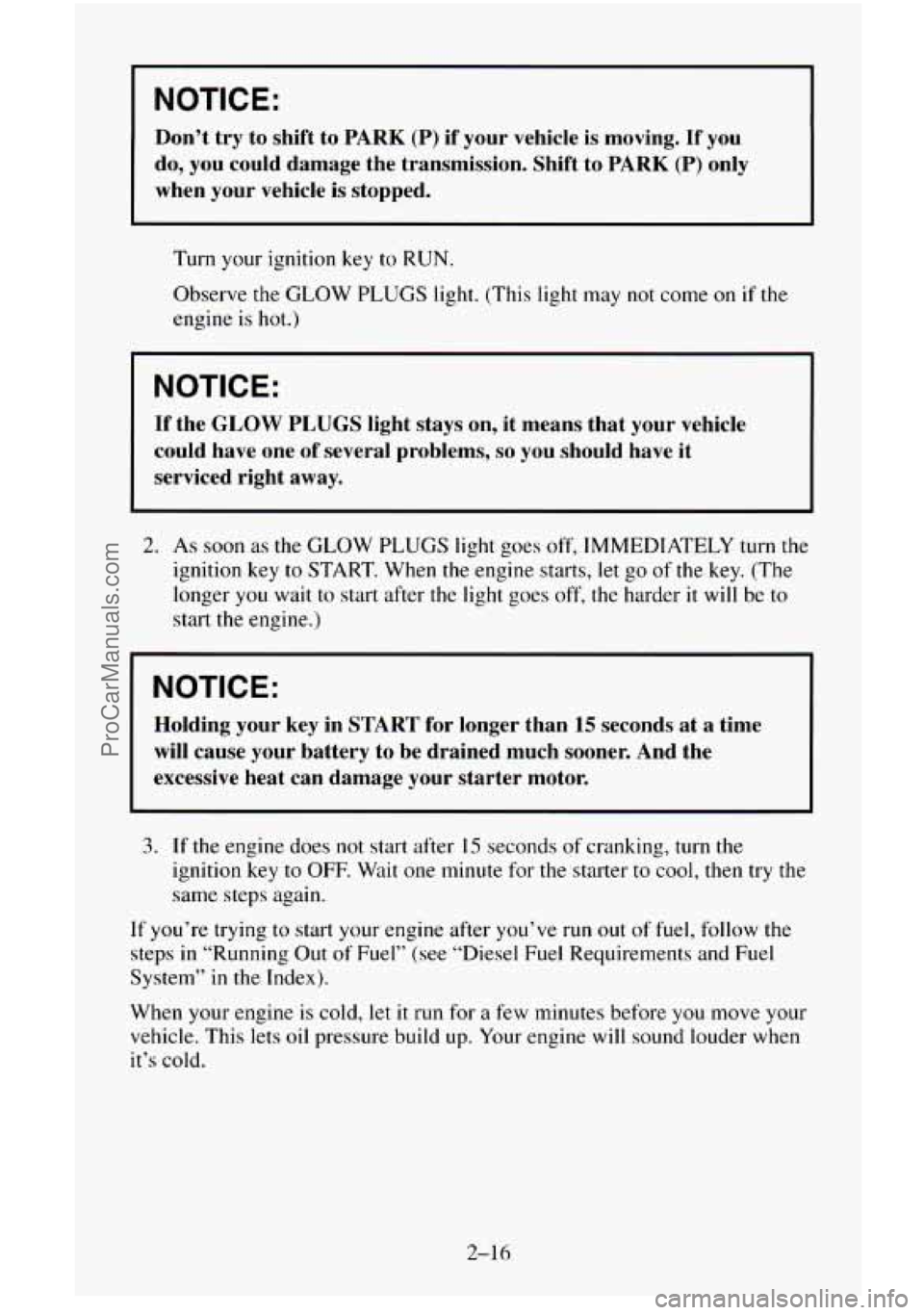
NOTICE:
Don’t try to shift to PARK (P) if your vehicle is moving. If you
do, you could damage the transmission. Shift to PARK
(P) only
when your vehicle is stopped.
Turn your ignition
key to RUN.
Observe the GLOW PLUGS light. (This light may not come on if the
engine is hot.)
NOTICE:
If the GLOW PLUGS light stays on, it means that your vehicle
could have one
of several problems, so you should have it
serviced right
away.
2. As soon as the GLOW PLUGS light goes off, IMMEDIATELY turn the
ignition key to START. When the engine starts, let go of the key. (The
longer you wait to start after the light goes off, the harder it will be to
start the engine.)
NOTICE:
Holding your key in START for longer than 15 seconds at a time
will cause your battery to be drained much sooner. And the
excessive heat can damage your starter motor.
3. If the engine does not start after 15 seconds of cranking, turn the
ignition key
to OFF. Wait one minute for the starter to cool, then try the
same steps again.
If you’re trying to start your engine after you’ve run out of fuel, follow the
steps
in “Running Out of Fuel” (see “Diesel Fuel Requirements and Fuel
System”
in the Index).
When your engine is cold, let it
run for a few minutes before you move your
vehicle. This lets oil pressure build up. Your engine will sound louder when
it’s cold.
2-16
ProCarManuals.com
Page 143 of 486
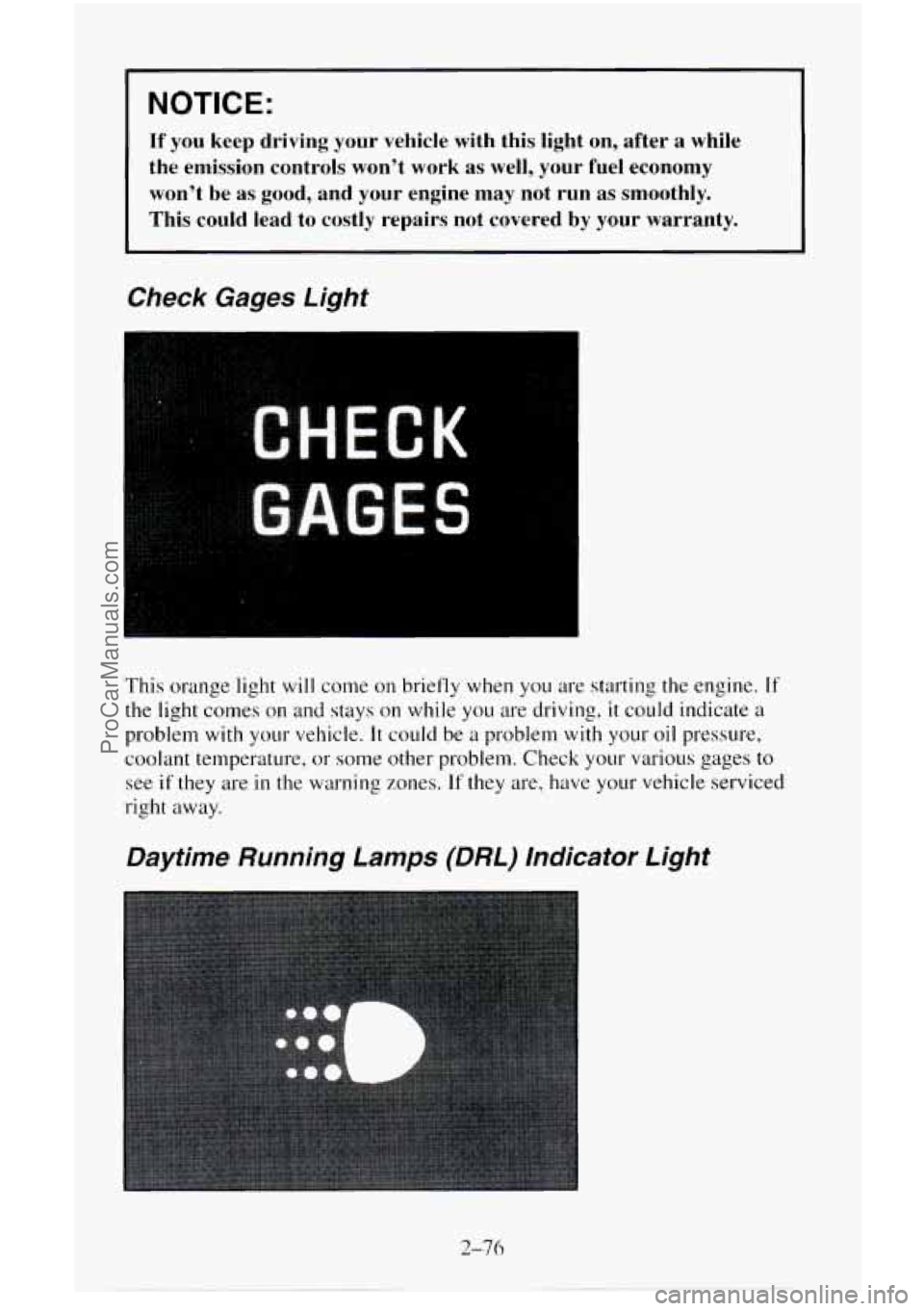
NOTICE:
If’ you keep driving your vehicle with this light on, after a whi\
le
the emission controls won’t work as well, your
fuel economy
won’t be as
good, and your engine may not run as smoothly.
This could lead to costly repairs not covered by your warranty\
.
Check Gages Light
This orange light will come on briefly when you are starting the engine. If
the light comes on and stays on while you are driving, it could indicate a
problem
with your vehicle. It could be a problem with your oil pressure,
coolant temperature, or some other problem. Check your various gages to
see
if they are in the warning zones. If they are, have your vehicle serviced
right away.
Daytime Running Lamps (DRL) Indicator Light
2-76
ProCarManuals.com
Page 147 of 486
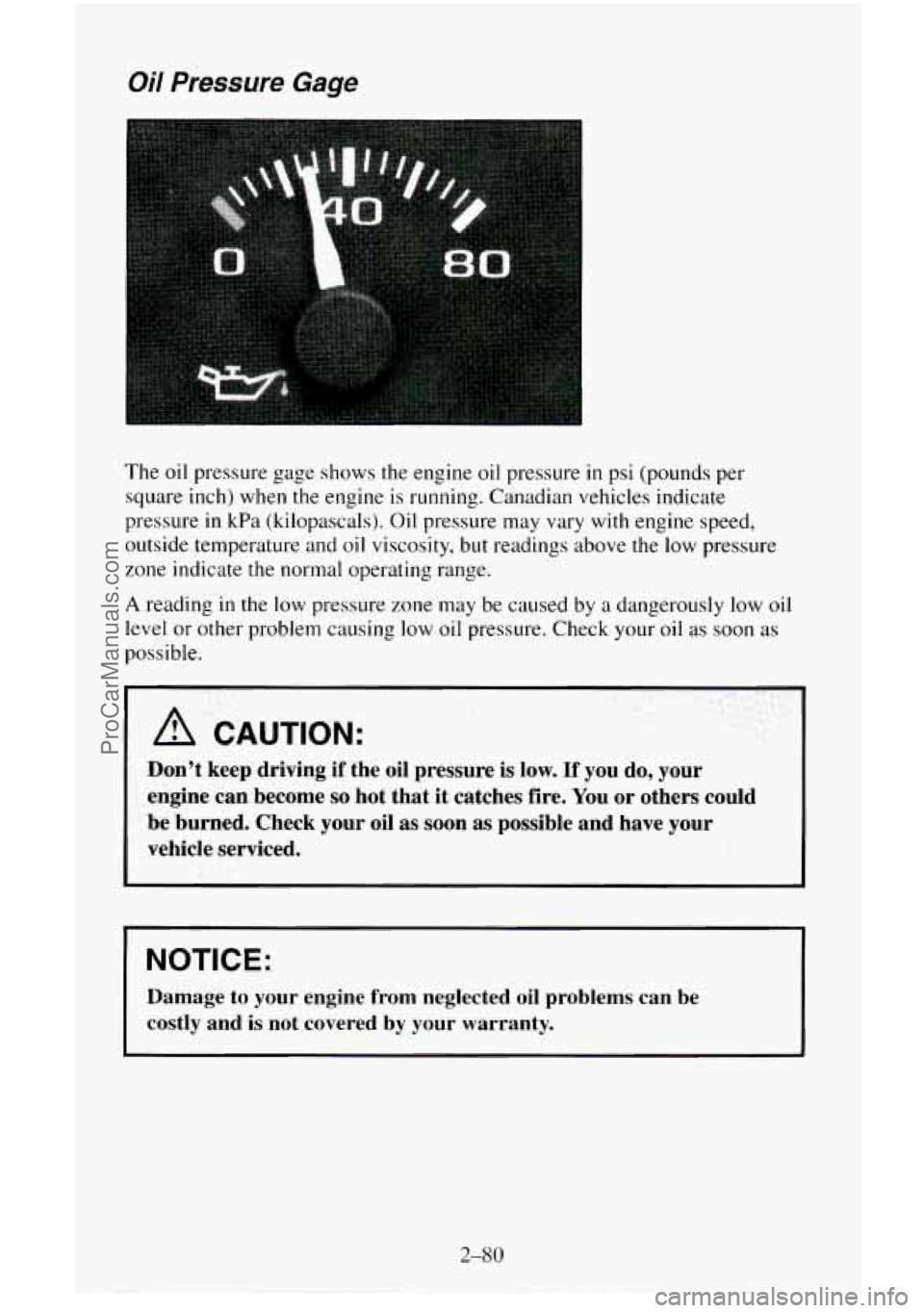
Oil Pressure Gage
The oil pressure gage shows the engine oil pressure in psi (pounds per
square inch) when the engine is running. Canadian vehicles indicate
pressure
in kPa (kilopascals). Oil pressure may vary with engine speed,
outside temperature and
oil viscosity, but readings above the low pressure
zone indicate the normal operating range.
A reading in the low pressure zone may be caused by a dangerously low oil
level or other problem causing
low oil pressure. Check your oil as soon as
possible.
A CAUTION:
Don’t keep driving if the oil pressure is low. If you do, your
engine can become
so hot that it catches fire. You or others could
be burned. Check your oil as soon
as possible and have your
vehicle serviced.
NOTICE:
Damage to your engine from neglected oil problems can be
costly and is not covered
by your warranty.
2-%O
ProCarManuals.com
Page 211 of 486
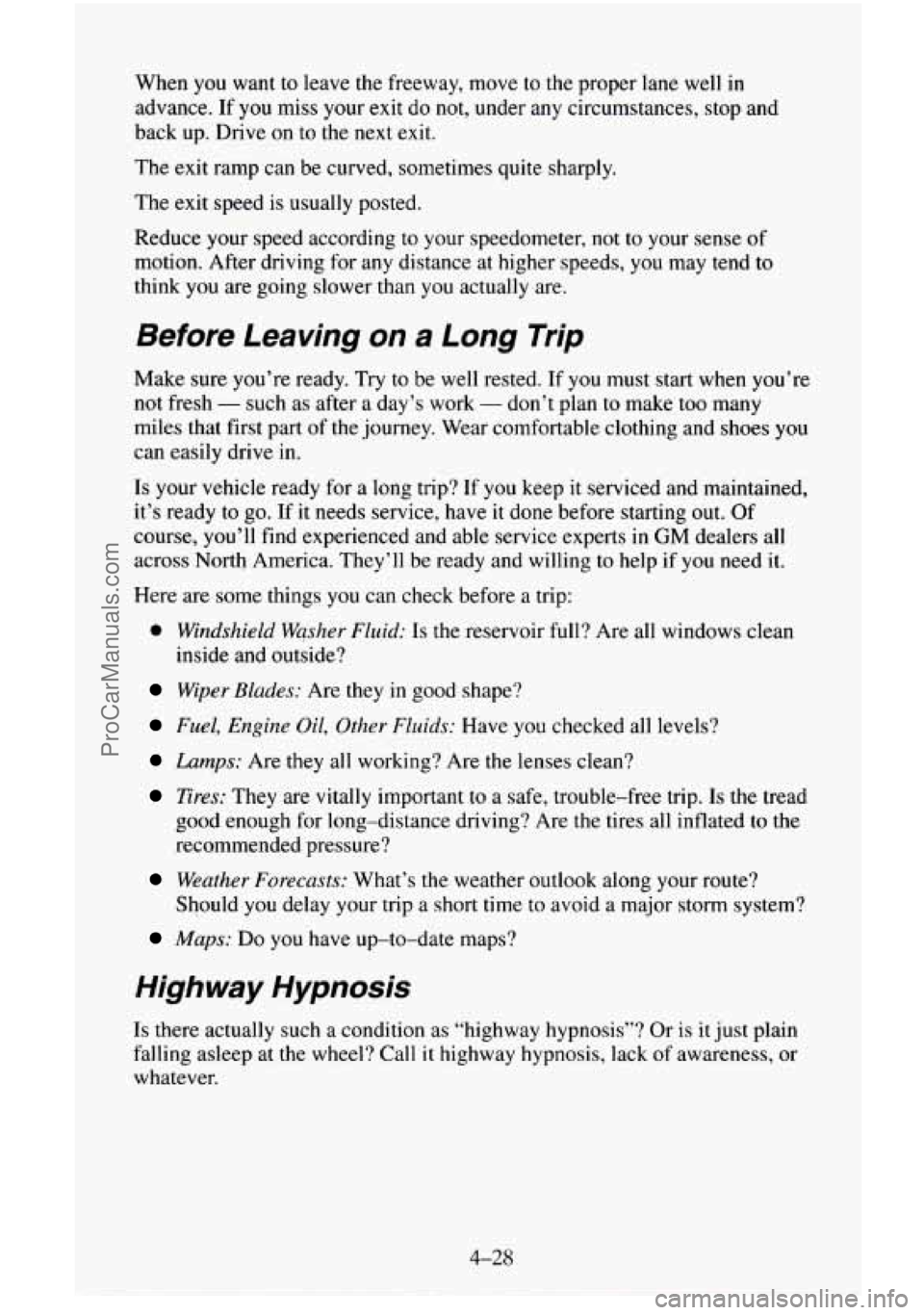
When you want to leave the freeway, move to the proper lane well in
advance. If you miss your exit do not, under any circumstances, stop and
back up. Drive on to the next exit.
The exit ramp
can be curved, sometimes quite sharply.
The exit speed
is usually posted.
Reduce your speed according to your speedometer, not to your sense of
motion. After driving for any distance at higher speeds, you may tend
to
think you are going slower than you actually are.
Before Leaving on a Long Trip
Make sure you’re ready. Try to be well rested. If you must start when you’re
not fresh
- such as after a day’s work - don’t plan to make too many
miles that first part of the journey. Wear comfortable clothing and
shoes you
can easily drive in.
Is your vehicle ready for a long trip? If you keep it serviced and maintained,
it’s ready to go. If
it needs service, have it done before starting out. Of
course, you’ll find experienced and able service experts in
GM dealers all
across
North America. They’ll be ready and willing to help if you need it.
Here are some things you can check before
a trip:
0 Windshield Washer Fluid: Is the reservoir full? Are all windows clean
inside and outside?
Wiper Blades: Are they in good shape?
Fuel, Engine Oil, Other Fluids: Have you checked all levels?
Lamps: Are they all working? Are the lenses clean?
Tires: They are vitally important to a safe, trouble-free trip. Is the tread
good enough for long-distance driving? Are the tires all inflated to the
recommended pressure?
Should you delay your trip a short time to avoid a major
storm system?
Weather Forecasts: What’s the weather outlook along your route?
Maps: Do you have up-to-date maps?
Highway Hypnosis
Is there actually such a condition as “highway hypnosis”? Or is it just plain
falling asleep
at the wheel? Call it highway hypnosis, lack of awareness, or
whatever.
ProCarManuals.com
Page 244 of 486
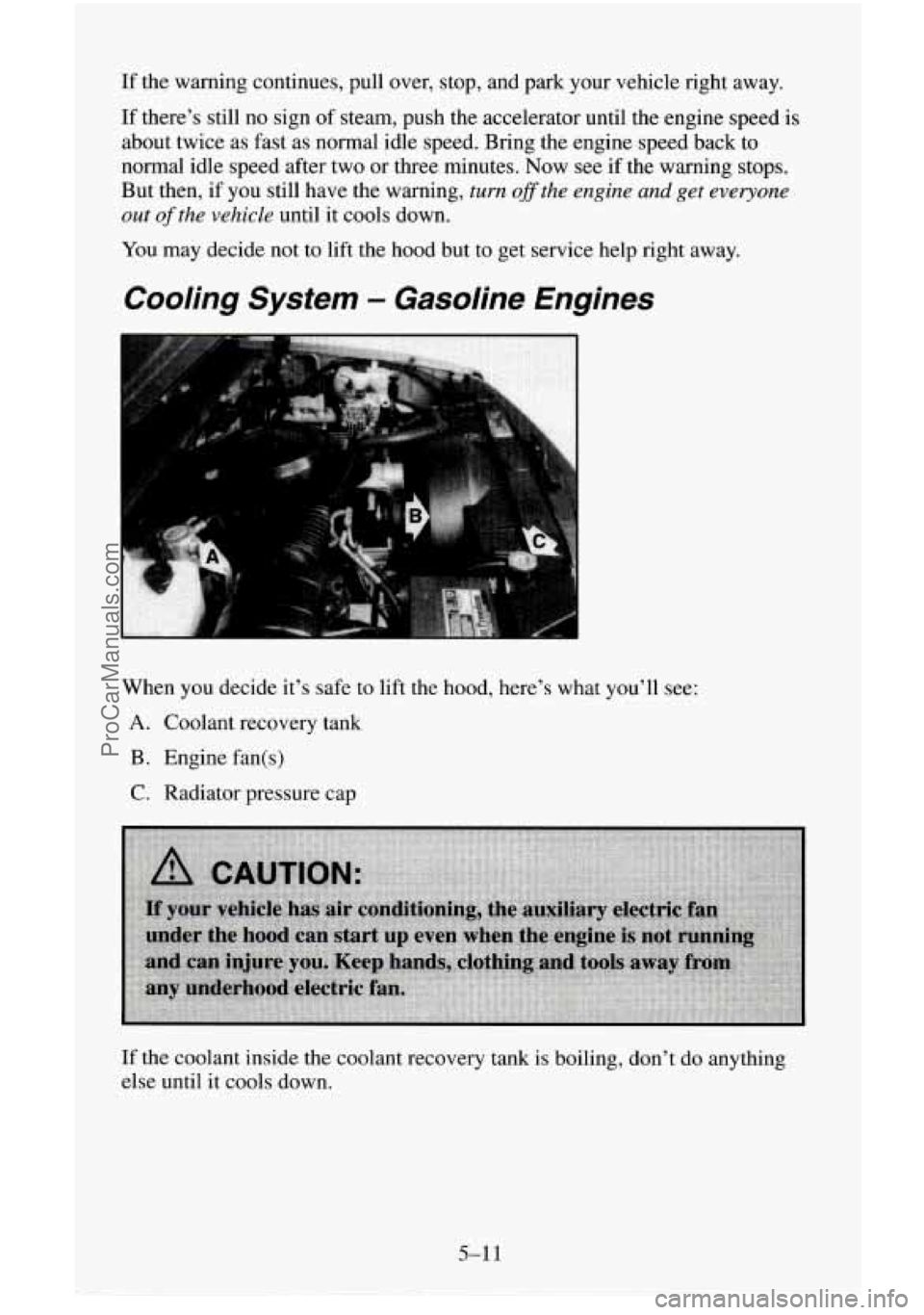
If the warning continues, pull over, stop, and park your vehicle right away.
If there’s still no sign of steam, push the accelerator until the engine speed is
about twice as fast as normal idle speed. Bring the engine speed back
to
normal idle speed after two or three minutes. Now see if the warning stops.
But then, if you still have the warning,
turn ofthe engine and get everyone
out
of the vehicle until it cools down.
You may decide not to lift the hood but to get service help right away.
Cooling System - Gasoline Engines
When you decide it’s safe to lift the hood, here’s what you’ll see:
A. Coolant recovery tank
B . Engine fan( s)
C. Radiator pressure cap
If the coolant inside the coolant recovery tank is boiling, don’t do anything
else until
it cools down.
5-1 1
ProCarManuals.com
Page 251 of 486
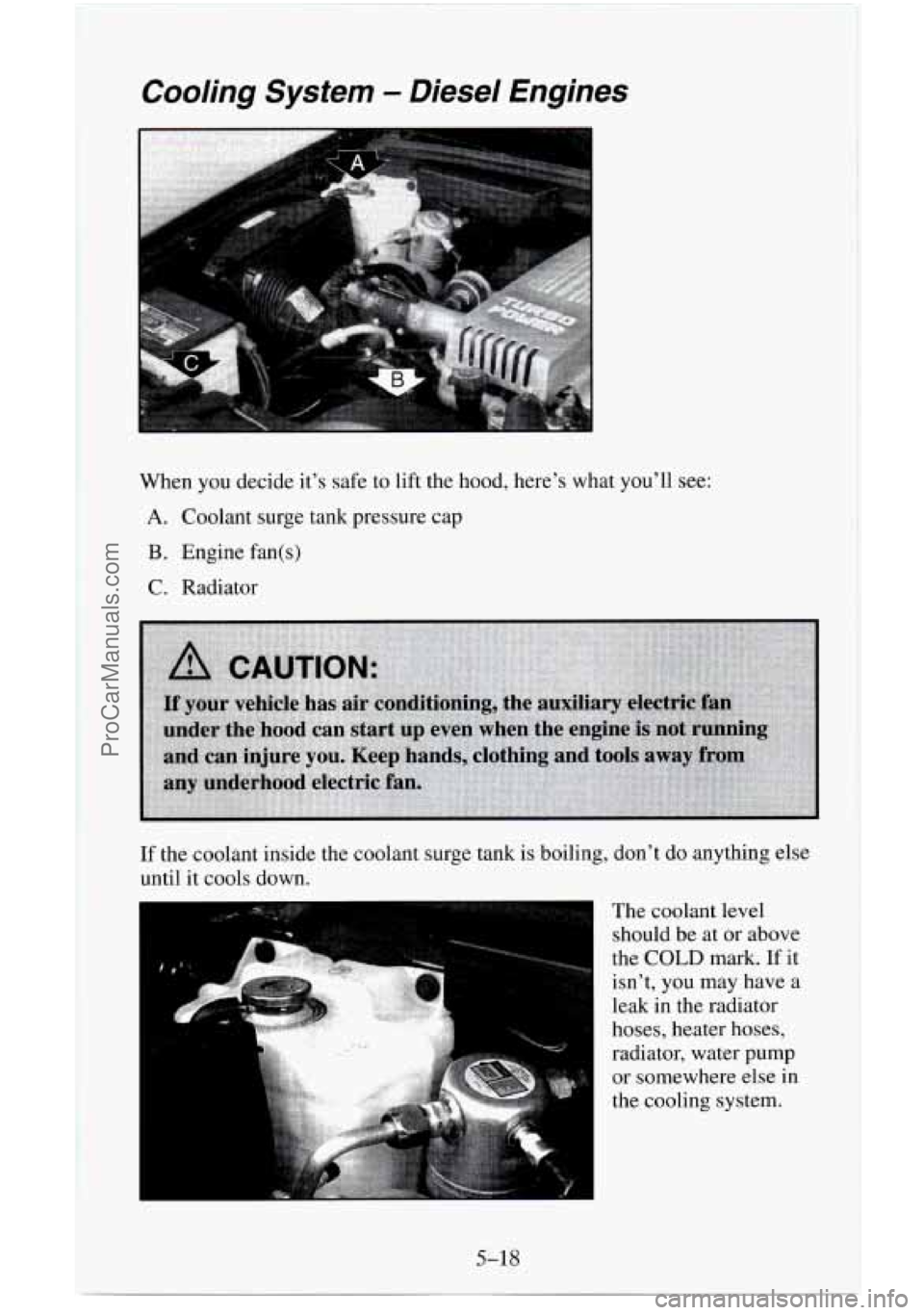
Cooling System - Diesel Engines
When you decide it’s safe to lift the hood, here’s what you’ll see:
A. Coolant surge tank pressure cap
B. Engine fan(s)
C. Radiator
If the coolant inside the coolant surge tank is boiling, don’t do anything else
until
it cools down.
The coolant level
should be at or above
the
COLD mark. If it
isn’t,
you may have a
leak in the radiator
hoses, heater hoses,
radiator, water pump
1 or somewhere else in
the cooling system.
5-18
ProCarManuals.com
Page 341 of 486
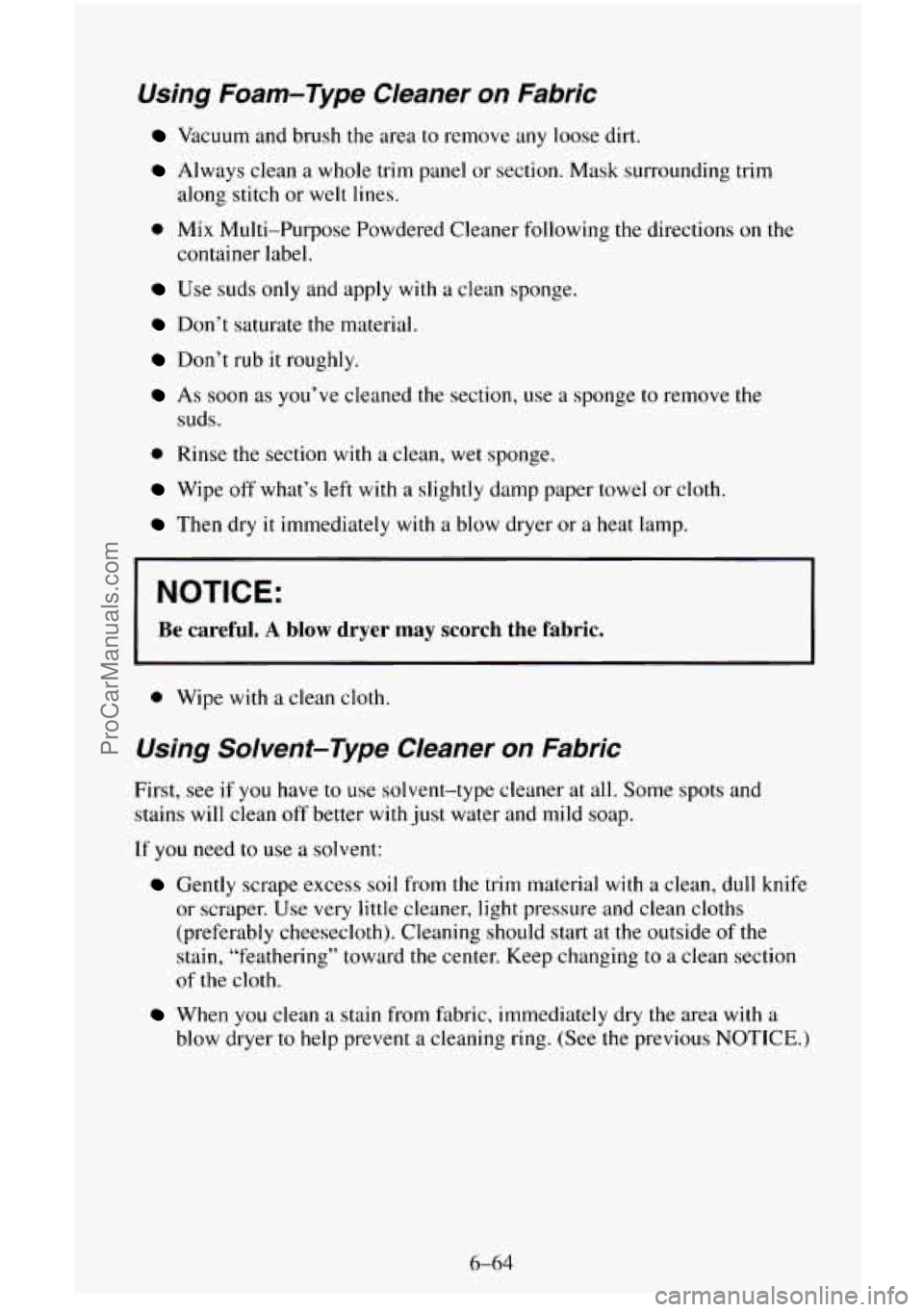
Using Foam-Type Cleaner on Fabric
Vacuum and brush the area to remove any loose dirt.
Always clean a whole trim panel or section. Mask surrounding trim
along stitch or welt lines.
0 Mix Multi-Purpose Powdered Cleaner following the directions on the
Use suds only and apply with a clean sponge.
Don’t saturate the material.
Don’t rub it roughly.
As soon as you’ve cleaned the section, use a sponge to remove the
0 Rinse the section with a clean, wet sponge.
Wipe off what’s left with a slightly damp paper towel or cloth.
Then dry it immediately with a blow dryer or a heat lamp.
container
label.
suds.
NOTICE:
Be careful. A blow dryer may scorch the fabric.
0 Wipe with a clean cloth.
Using Solvent-Type Cleaner on Fabric
First, see if you have to use solvent-type cleaner at all. Some spots and
stains will clean off better with
iust water and mild soap.
If you need to use a solvent:
Gently scrape excess soil from the trim material with a clean, dull knife
or scraper. Use very little cleaner, light pressure and clean cloths
(preferably cheesecloth). Cleaning should start at the outside of the
stain, “feathering” toward the center. Keep changing to
a clean section
of the cloth.
When you clean a stain from fabric, immediately dry the area with a
blow dryer to help prevent a cleaning ring. (See the previous NOTICE.)
6-64
ProCarManuals.com
Page 345 of 486
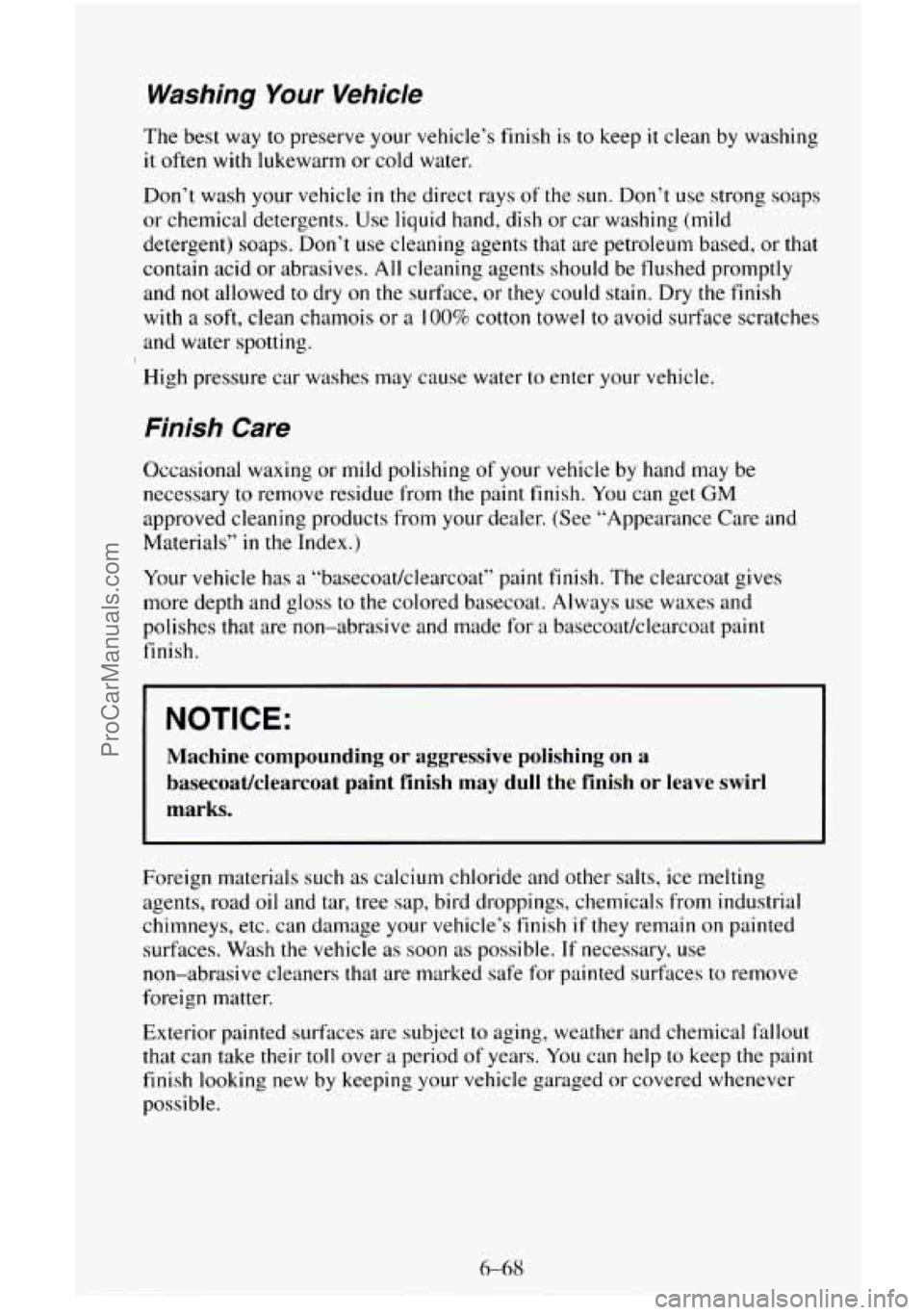
Washing Your Vehicle
The best way to preserve your vehicle’s finish is to keep it clean by washing
it often with lukewarm or cold water.
Don’t wash your vehicle
in the direct rays of the sun. Don’t use strong soaps
or chemical detergents. Use liquid hand, dish or car washing (mild
detergent) soaps. Don’t use cleaning agents that are petroleum based, or
that
contain acid or abrasives. All cleaning agents should be flushed promptly
and
not allowed to dry on the surface, or they could stain. Dry the finish
with a soft, clean chamois or a 100% cotton towel to avoid surface scratches
and water spotting.
High pressure car washes may cause water
to enter your vehicle.
Finish Care
Occasional waxing or mild polishing of your vehicle by hand may be
necessary to remove residue from the paint finish.
You can get GM
approved cleaning products from your dealer. (See “Appearance Care and
Materials”
in the Index.)
Your vehicle has
a “basecoat/clearcoat” paint finish. The clearcoat gives
more depth
and gloss to the colored basecoat. Always use waxes and
polishes that are non-abrasive and made for
a basecoatklearcoat paint
finish.
NOTICE:
Machine compounding or aggressive polishing on a
basecoatklearcoat paint finish may dull the finish or leave swirl
marks.
Foreign materials such as calcium chloride and other salts, ice melting
agents, road oil and tar, tree sap, bird droppings, chemicals from industrial
chimneys, etc. can damage your vehicle’s finish
if they remain on painted
surfaces. Wash the vehicle
as soon as possible. If necessary, use
non-abrasive cleaners that are marked safe for painted surfaces to remove
foreign matter.
Exterior painted surfaces are subject
to aging, weather and chemical fallout
that can take their toll over
a period of years. You can help to keep the paint
finish looking new by keeping your vehicle garaged or covered whenever
possible.
6-68
ProCarManuals.com
Page 374 of 486
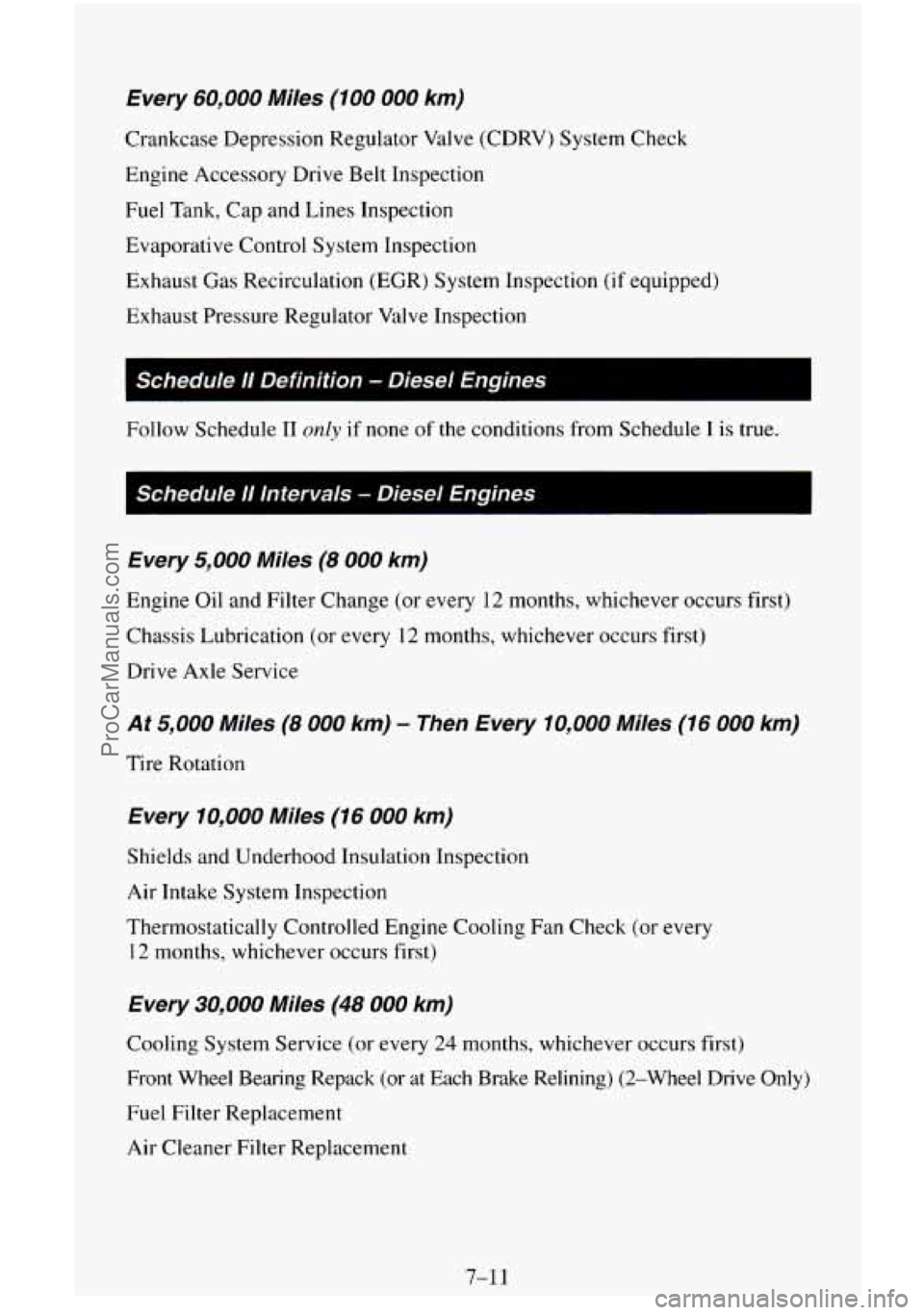
Every 60,000 Miles (100 000 km)
Crankcase Depression Regulator Valve (CDRV) Svstem Check
Engine Accessory Drive Belt Inspection
Fuel Tank, Cap and Lines Inspection
Evaporative Control System Inspection
Exhaust Gas Recirculation (EGR) System Inspection
(if equipped)
Exhaust Pressure Regulator Valve Inspection
Follow Schedule I1
onZy if none of the conditions from Schedule I is true.
Every 5,000 Miles (8 000 km)
Engine Oil and Filter Change (or every 12 months, whichever occurs first)
Chassis Lubrication (or every
12 months, whichever occurs first)
Drive Axle Service
At 5,000 Miles (8 000 km) - Then Every 10,000 Miles (16 000 km)
Tire Rotation
Every 10,000 Miles (16 000 krn)
Shields and Underhood Insulation Inspection
Air Intake System Inspection
Thermostatically Controlled Engine Cooling Fan Check
(or every
12 months, whichever occurs first)
Every 30,000 Miles (48 000 km)
Cooling System Service (or every 24 months, whichever occurs first)
Front Wheel Bearing Repack (or at Each Brake Relining) (2-Wh\
eel Drive Only)
Fuel Filter Replacement
Air Cleaner Filter Replacement
7-1 1
ProCarManuals.com